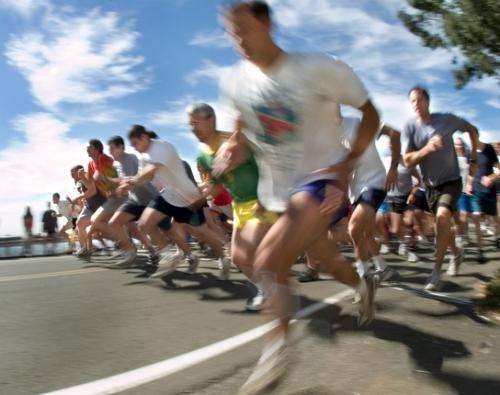Running, even in excess, doesn't lead to more osteoarthritis and hip replacements

(Medical Xpress)—Need another reason to dust off those running shoes in the back of the closet? It turns out that running longer distances actually decreases a person's risk of osteoarthritis and hip replacements, according to new research conducted by Paul Williams of Berkeley Lab's Life Sciences Division.
His results counter the widely held view that frequent running leads to joint injuries, which may be one of the reasons many people choose to walk for exercise. Williams, however, found that running doesn't pose a greater risk than walking when it comes to osteoarthritis and hip replacements.
Osteoarthritis is the leading cause of disability in older people. It's predicted to become the fourth most common medical condition in women.
The research involved nearly 75,000 runners who were followed for an average of seven years. In that time, 2004 people were diagnosed by their physician with osteoarthritis and 259 had hip replacements. They were compared to nearly 15,000 walkers, among whom 696 were diagnosed with osteoarthritis and 114 had hip replacements during their 6-year follow-up.
Those who ran more than 1.2 miles per day were at 15 percent less risk of osteoarthritis and 35 percent less risk of hip replacements than more sedentary men and women. These risks did not increase at higher mileages, even in runners who logged multiple marathons per year.
Further analyses revealed that running reduced the risk of these injuries due, in part, to the sport's association with lower body mass index. Williams notes that other factors may be at work.
"It's important to not think of the body as a car," he says. "A car's engine bearings will eventually wear out. However, a car doesn't add more bearing material when you drive it more, whereas the body will adapt to exercise by thickening joint cartilage and adding cartilage proteoglycans to our joints—loss of proteoglycans is an early feature of osteoarthritis."
His findings are the latest gems from the National Runners' and Walkers' Health Studies, which Williams launched in 1991. The studies include nearly 90,000 participants who were recruited to study the health benefits and risks of physical activity.
Williams also found that people who engaged in more non-running and non-walking exercises had increased rates of osteoathritis and hip replacements.
"Osteoarthritis has been reported to increase in soccer players and weight lifters, and in occupations requiring knee-bends, kneeling, or squats, which may be more characteristic of exercises performed in gyms, circuit training, and aerobic classes," he says.
















